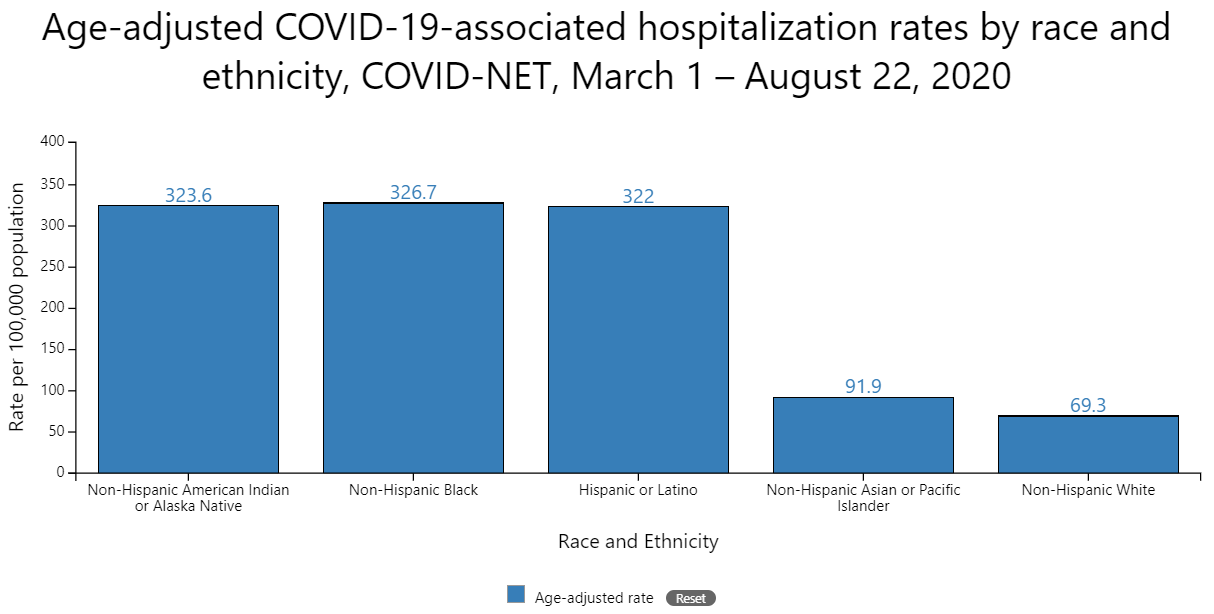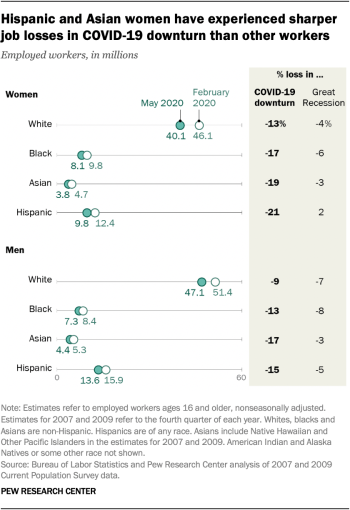Racial and ethnic minority groups in the United States are being disproportionately impacted by the health and economic effects of the COVID-19 crisis. Read to learn more about the extent of these effects on the fastest growing segment of the U.S. labor force, Hispanics, and the role Corporate America has in helping to address some of the structural challenges that contribute to these inequalities.
Many Americans are struggling with the lingering economic impact of the COVID-19 crisis. With an unemployment rate of 13.3 percent as of May 2020,[1] and with around 4 in 10 CEOs reporting that their companies have furloughed, laid off, or cut their workers’ pay, many Americans are grappling with the reality of a worsening economic situation as well as the constant threat of an unfamiliar health crisis.[2] The negative health and economic effects of the COVID-19 pandemic are amplified, however, for certain racial and ethnic minority groups in the United States.
 Chart from the Center for Disease Control and Prevention. Click here to see more data.
Chart from the Center for Disease Control and Prevention. Click here to see more data.
In fact, the COVID-19 pandemic has highlighted many of the health and economic disparities experienced by racial and ethnic minority groups in the United States. Understanding the social determinants of health is key to understanding how to curb the effects of the pandemic. Even before COVID-19, racial and ethnic minority groups were more likely to be employed in low-wage, non-exempt jobs with an increased risk of job loss during times of economic downturn.[3] Additionally, minorities are more likely to live in more dense urban areas and to live in multigenerational households, thereby increasing their exposure risk. In fact, 27 percent of Hispanics live in multigenerational households as compared to 16 percent of whites.[4] The icing on the cake? Racial and ethnic minorities are less likely to have health insurance – one in five Hispanics (19 percent) are uninsured – and more likely to have underlying health conditions that put them at greater risk for negative outcomes if they contract COVID-19.[5] These longstanding systemic social inequalities have translated to Hispanics and other minorities being at a higher risk of contracting COVID-19, regardless of age. The CDC reports that those of Hispanic or Latino origin have a COVID-19 hospitalization rate approximately 4.6 times higher than that of non-Hispanic white persons.[6]
WHAT DOES THIS MEAN FOR THE HISPANIC LABOR FORCE?
Earlier we mentioned 4 in 10 CEOs reported their companies have furloughed, laid off workers, or cut their pay – well, Hispanics are nearly twice as likely as their white counterparts to have lost their jobs during the COVID-19 shutdowns. In fact, 20 percent of Hispanic adults reported being laid off or furloughed compared to 11 percent of white adults.[7] If most jobs being cut are low-paying, non-exempt jobs – and Hispanics represent 13 percent of non-exempt employees – then it should come as no surprise that the Hispanic labor force is being hit hard by the effects of COVID-19.[8]
What’s more, Hispanic women have experienced a steeper decline in employment due to COVID-19 than women or men in any other racial or ethnic group. The Pew Research Center cites one potential reason for this being that Hispanic women are more likely than others to be employed in the leisure and hospitality industry, an industry that has been hit especially hard by the COVID-19 downturn. According to Pew, three sectors – leisure and hospitality, education and health services, and retail trade – account for 59 percent of the total loss in non-farm jobs between February and May 2020.[9] This ended up having a disproportionate effect on women since these sectors also accounted for 47 percent of the jobs held by women, compared to 28 percent for men.[10]
Not everyone can work from home. In fact, more than 15 million Hispanics not only work in, but are also overrepresented in industries with an increased risk of spreading COVID-19 and with a low ability to work remotely.[11] Hispanic-owned small businesses are also being disproportionately impacted. In a recent Stanford survey, 86 percent of Latino business owners reported immediate negative effects of COVID-19, with 65 percent indicating they would not be able to sustain their businesses for more than six months if current conditions continued.[12] Much of this pressure comes from the fact that their employees cannot work remotely and, for businesses that were deemed “essential,” that sales are down since customers just aren’t showing up like they had previously. Additionally, 55 percent of Latino-owned businesses are still waiting for Paycheck Protection Program loan approval, adding further uncertainty and strain.[13]
WHAT CAN CORPORATE AMERICA DO TO HELP?
Although these statistics may seem discouraging, there are a number of things companies can do to make sure their Hispanic employees are receiving the necessary support. For starters, companies can help make sure employees and the communities they work in are informed as to where they can receive care and testing. Communities of color, as a result of being uninsured at a higher rate, are at an increased risk of not knowing where to go to obtain testing since they lack access to healthcare resources.[14] Ensuring that employees are well-informed of their options will go a long way.
Companies can work on strengthening their paid leave policies, especially for low-wage and part-time workers. The CARES Act includes provisions for paid sick, family, and medical leave but only for businesses with less than 500 employees. This means that only 25 percent of private sector employees are covered.[15] Access to paid leave will reduce the negative impact on the macroeconomy – employees on unpaid leave consume less thereby decreasing overall demand.[16] Access to paid leave will also decrease the rate of COVID-19 spread, since employees won’t feel forced to go to work despite being ill out of fear they won’t be able to make ends meet.
Companies can also work on expanding initiatives to support Hispanic small business owners. For starters, companies can consider offering emergency grants to support small businesses that are being especially hit hard right now. Access to short-term liquidity is crucial for small businesses and so relief in the form of grants could provide them with extra protection. Companies can work with their corporate foundations and treasury department to develop such programs.[17] Companies with programs like this already in place can work on expanding awareness of such programs to communities that are in special need of assistance. Additionally, companies can
- Reduce payment terms, advance payments or credit to small/diverse suppliers
- Provide tools for diverse businesses to access SBA economic injury disaster loans
- Share risk management practices with small business partners[18]
Finally, tracking is more crucial than ever. We have written previously about the importance of tracking diversity and inclusion metrics for companies and it is no less salient now. Tracking ultimately allows organizations to create more detailed roadmaps of where they’ve been, where they currently are, and where they want to go with their diversity and inclusion efforts. During the era of COVID-19, it has become especially important for companies to track the impact COVID is having on their workforce. Companies need to be able answer questions like what are the impacts of this pandemic? Who is being impacted? How do these impacts affect different demographic groups? Which levels of the professional pipeline are being hardest hit right now? Are the measures that have been put in place actually having a positive impact? Tracking will allow companies to gain a more nuanced insight into these questions and more. The answers to these questions are not only crucial to surviving the current economic downturn but also for when it comes time to rebuild.
CONCLUSION
COVID-19 is a challenge that all Americans are grappling with right now but certain racial and ethnic demographic groups are being disproportionately impacted by job loss and higher infection rates. COVID-19 has truly highlighted the persistent and pervasive racial gap in the American economy. As disheartening as these inequalities can be, Corporate America has a chance to make a significant difference by helping to address the many structural challenges that contribute to these inequalities. The road ahead is long but by raising awareness around COVID care and testing, strengthening paid leave policies for all workers, developing their small business support programs, and tracking the effect COVID-19 is having on their workforce, Corporate America can take a leading role in helping Americans get through this difficult time. Hispanics will play a key role in recovery post-COVID and Corporate America has an opportunity to help ensure more equitable economic outcomes for everyone.
Looking for more information regarding COVID-19 and it’s impact at the local, state, federal, even country level? Visit this page for an interactive map and critical trends that are updated daily. You can also use the CDC’s COVID Racial Data Tracker to look at the most complete and up-to-date race and ethnicity data on COVID-19 in the United States.
Recursos adicionales sobre COVID–19 en español incluyen:
- El Centro de Control y Prevención de Enfermedades tiene información en español
- Respuesta del Gobierno Federal
- Respuesta de los Gobiernos de Cada Estado

